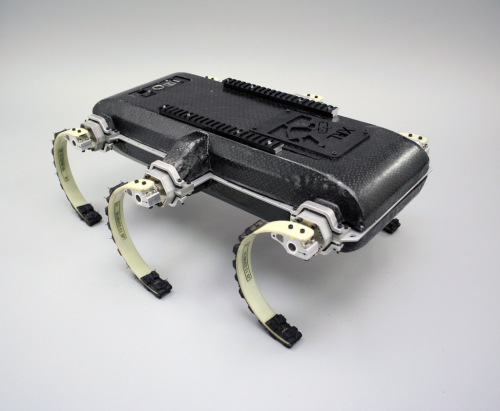May 10, 2013 weblog
The RHex takes a leap at robotics conference (w/ Video)

(Phys.org) —University of Pennsylvania robotics teams are at it again, this time coming up with a robot that aggressively expands the range of how many moves can be made to successfully cross rough terrain full of climbing and leaping challenges. Aaron M. Jonson, and D. E. Koditschek from the University of Pennsylvania's Kod *lab (a subsidiary of the school's GRASP Lab) presented their research, "Toward a Vocabulary of Legged Leaping," at ICRA 2013 in Germany. The video of their device in motion, showing gymnastic-style feats, recently made the rounds of tech sites. The authors also won attention in being one of five finalists for Best Student Paper Award. ICRA stands for the IEEE International Conference on Robotics and Automation.
The draw toward their creation is in its ability to not only scurry forth but to leap, do backflips, ascend surfaces, climbing up onto a 73cm high, and cross 60 cm gaps, jumping from one plank to another.
IEEE Spectrum notes that the researchers have progressed toward an X-RHex Light, or XRL, which weighs 6.7 kilograms (14.8 pounds) and has a body length of 51 centimeters (20 inches). The robot has six C-shaped legs, actuated by motors. X-RHex can cross a variety of terrains, including asphalt, grass, sand, mud, and rocks.) RHex began as part of a large DARPA funded consortium. A variety of RHex platforms have been developed ever since.
Their "legged-leaping" paper, details their work. "We exhibit on a RHex robot some of the most interesting 'words' formed by these achievable path sequences, documenting unprecedented levels of performance and new application possibilities that illustrate the value of understanding and expressing this vocabulary systematically."
Complex hurdles, they wrote, may require special leap capabilities, and that is their focus. They explain further:: "We have presented the space of legged transitions from complete rest to full flight as generated by combinatorial mixtures of various hybrid dynamical systems indexed by the cells of a "ground reaction complex." They see the value of this exploration as affording new behaviors that "extend the range of terrains that the RHex robot can negotiate."
More information:
kodlab.seas.upenn.edu/uploads/ … n/JohnsonLeaping.pdf
kodlab.seas.upenn.edu/XRHex/XRL
via IEEE Spectrum
© 2013 Phys.org





















